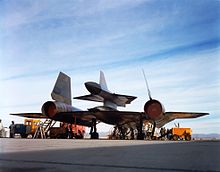5 March 1966 – The D-21 Tagboard drone “was first launched from an M-21 on 5 March 1966.[8] The drone was released but stayed close to the M-21’s back for a few seconds, which seemed like “two hours” to the M-21 crew.[9] A second launch took place on 27 April 1966; the D-21 reached its operational altitude of 90,000 ft (27,000 m) and speed of over Mach 3.3 (2,200 mph; 3,600 km/h), though it was lost due to a hydraulic pump failure after a flight of over 1,200 nmi (1,400 mi; 2,200 km). The USAF’s interest in the program continued and more D-21s were ordered after the second launch.[8] A third flight took place on 16 June with the D-21 flying 1,550 nmi (1,800 mi; 2,900 km) through its complete flight profile, though its camera hatch was not released due to an electronics failure.[10]” 
Background: In the 1960s Lockheed’s secret Skunk Works developed the Mach 3 A-12 reconnaissance aircraft for the Central Intelligence Agency (CIA). After the shooting down of the U-2 piloted by Gary Powers in 1960, a number of different concepts were proposed as alternatives. Kelly Johnson, the leader of Skunk Works, developed the concept of a long-range drone that used much of the A-12’s technology.
In October 1962 the CIA and the United States Air Force (USAF) instructed Lockheed to study a high-speed, high-altitude drone concept.
Operational History –
Four operational missions with the D-21B took place under the codename of Senior Bowl. These were conducted over the People’s Republic of China from 9 November 1969 to 20 March 1971 to spy on the Lop Nor nuclear test site. The USAF’s 4200th Support Squadron, based at Beale Air Force Base, California, flew the missions, usually from Andersen Air Force Base in Guam.[19]
The Chinese government never reported spotting the D-21B in flight. The first one failed to turn around and continued straight on, crashing in the Soviet Union.[20] Another test flight was conducted on 20 February 1970 in a successful attempt to correct any problems. The second operational mission, however, was not until 16 December 1970. The D-21B reached Lop Nor and returned to the recovery point, but the hatch had a partial parachute failure and was lost at sea with its photographs.[17]
During the third operational mission, on 4 March 1971, the D-21B flew to Lop Nor and returned, and released the hatch, which deployed its parachute, but the midair recovery failed and the hatch fell into the water. The destroyer that tried to retrieve the hatch ran it down and it sank. The fourth and last, operational flight of the D-21B was on 20 March 1971. It was lost over China on the final segment of the route over China’s Yunnan province;[21] wreckage was found by local authorities. In 2010, after being in the junkyard of the China Aviation Museum for years, the wreckage was moved to the exhibition area.[22]
On 23 July 1971, the D-21B program was canceled due to its poor success rate, the introduction of a new generation of photo reconnaissance satellites, and President Richard Nixon’s rapprochement with China.[23] A total of 38 D-21 and D-21B drones had been built, 21 of which were expended in launches. The remaining 17 were initially stored at Norton Air Force Base, California, then moved to the Davis-Monthan Air Force Base “boneyard” near Tucson, Arizona,[24] in 1976 and 1977. With the base open to the public, the D-21 drones were quickly spotted and photographed. The Air Force called them GTD-21Bs with the GT standing for Ground Training.[25]
The fate of the D-21 that had disappeared on the first operational flight was finally revealed in February 1986 when an official from the CIA returned a panel to Ben Rich that he had been given by a Soviet KGB agent. The drone had self-destructed over Siberia and the Soviets had recovered the wreckage.[26] The Tupolev design bureau reverse-engineered the wreck and produced plans for a Soviet copy, named the Voron (Raven), but it was never built.[27]
In the late 1990s, NASA considered using a D-21 to test a hybrid rocket-based combined cycle engine, which operates as a ramjet or rocket, depending on its flight regime. Ultimately NASA used a derivative of the agency’s X-43A hypersonic test vehicle for the experiments.”
Source: Wikipedia
